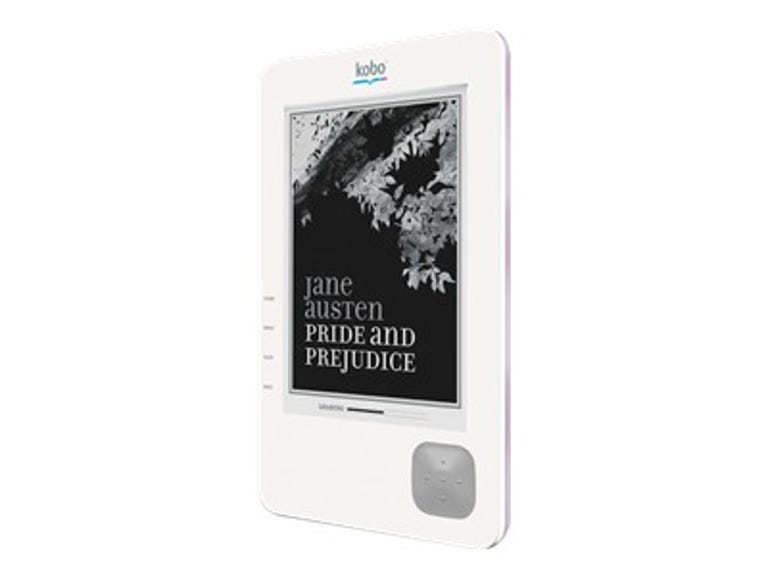 Why You Can Trust CNET
Why You Can Trust CNET Kobo Wireless eReader Wi-Fi review: Kobo Wireless eReader Wi-Fi
Kobo Wireless eReader Wi-Fi
Borders has been selling Kobo e-readers for a while and in recent weeks has been offering a version with built-in Wi-Fi for $99, discounted from its list price of $139.99.
The Good
The Bad
The Bottom Line
As the price suggests, the Kobo, which has the same-size 6-inch e-ink display as the Kindle and Nook, is a somewhat basic e-reader (the screen has 8 levels of gray, not 16), but it does offer wireless connectivity (unlike its predecessor) and 1GB of internal memory, and there's an SD card expansion slot for adding more (up to 4GB).
In case you don't know what the Borders connection with Kobo is, this is the synopsis: needing to have some sort of presence in the e-reader space, in 2009 the company acquired a stake in Kobo, which was originally called Shortcovers, a spinoff of Canada's Indigo Books & Music (Indigo remains the largest investor in the company). Now Kobo powers Borders' eBookstore.
On a side note, Kobo also has its own separate e-bookstore, as well its own iPhone, iPad, and Android apps for smartphones and tablets. Confusing? Just a bit.
The quick and dirty specs on the Kobo Wireless eReader:
- • 6-inch E Ink electronic paper display
- • 4.7 inches wide by 7.2 inches tall by 0.4 inch thick, 8 ounces
- • Available in three colors: onyx/black, silver, lilac
- • Resolution: 800x600 pixels
- • Gray scale: Eight-level gray scale
- • 1GB of internal memory (stores around 1,000 e-books)
- • SD-card expansion slot (up to 4GB)
- • Five adjustable font sizes, plus choice of Serif or San Serif
- • Sealed-in (not user-replaceable) battery provides up to two weeks of reading on a single charge
- • $139.99 MSRP, widely available for $99
- • USB cable included
- • Files supported: EPUB, PDF, Adobe DRM
The Kobo is fairly plain-looking, but it has a nice "quilted" back. We didn't have any serious issues with its appearance or feel, and it's designed better than the generic Aluratek Libre (street price: $125). At a hair under 8 ounces, it's relatively compact and lightweight and can be held in one hand for reading.
We found the script on the screen to be a little lighter on this e-reader than on some competing models and the text was not as sharply defined as it should be. Like other e-ink e-readers, there's some lag when you turn pages and go back and forth between books and the home menu. But it's worth noting that the lag is much more pronounced on this Kobo than on the latest-generation Kindle or Nook e-ink e-readers.
Navigating the device is fairly straightforward--you use a combination of the four-way directional pad (with a center select button) and the four buttons on the side of the device ("Home," "Menu," "Shop," and "Back"). To page forward, you click on the right side of the nav button, and to go back a page, you click the left side (alternatively, you can use the up/down sides of the button).
To put it bluntly, the whole experience feels sluggish compared with the Kindle or the Nook, and it's also worth mentioning that we discovered errors in the e-bookstore when we accessed it from the device. For example, e-books that were marked "free" were priced at 99 cents even though they were indeed free. Also, the store was inaccessible at times when it appeared that our Wi-Fi connection was fine.
To download e-books from the Borders store, you simply download them directly from the device after registering for an account. Alternatively, you can install the Borders desktop app on your Mac or Windows computer, and then "side-load" e-books you've purchased to the device via the USB port. You can also side-load PDF and EPUB files by simply dragging and dropping them onto the Kobo as if it were a storage device. In that regard, this is an "open device" like the Nook and Sony Reader. The big advantage there is the ability to "borrow" e-books from your local library--something you can't do with the Kindle.
You'd think that an e-reader with Wi-Fi would support wireless syncing of your Borders/Kobo library between it and a mobile phone running the Borders or the Kobo app, (Borders and Kobo already have separate apps available for the iPhone, iPad, and Android platforms), but we bought a book via the Borders app on an iPhone and it didn't transfer over to the device. As far as we could tell, there's no way to sync an e-book between the reader and apps on other devices. However, if you subscribe to a newspaper or magazine, new editions will automatically be delivered to the device once you're on a Wi-Fi network.
As far as extras go, unlike some other e-readers, the Kobo doesn't support viewing JPEG and other image files or MP3 audio files. As we said, aside from the built-in Wi-Fi, you get a pretty basic feature set.
In the end, the problem with this e-reader is that while it's OK and is fine to read on (though a little sluggish), competing e-readers like the Kindle and Nook are clearly superior in just about every way. True, you may be able to find the Kobo Wireless eReader for $99 on sale, but you really do get what you pay for. Our advice: pay the extra $40 or $50 for the Kindle or Nook--they're worth it.


